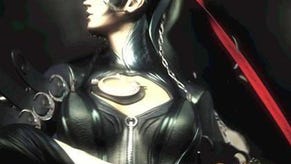Bayonetta: PS3/360 demo showdown
Digital Foundry dares to compare.
It began with a seemingly innocuous notice in Japanese games magazine Famitsu, where special mention was made that the PS3 version of Platinum Games' forthcoming Bayonetta is not being handled by the original developer. Quite why Platinum isn't at the conn for the conversion to the Sony platform remains something of a mystery, but the recent Japanese demo release offers some potential reasons, and it too highlights prominently that Platinum is not responsible for the port. So, is this a simple case of giving credit where it's due, or is the developer effectively disavowing itself of the PS3 version of the game?
It has to be said that there is much in the PS3 rendition that Platinum would most likely wish to distance itself from. In terms of raw performance, both Xbox 360 and PlayStation 3 games have their issues, but by virtually every criteria it is the PS3 version that comes off worse, as you can see from the media Digital Foundry has prepared. There's some Face-Off style comparison shots to gawp at, along with this 720p movie:
The game's engine-driven cut-scenes are intricate in detail and offer a close-up view of some of the more obvious differences between the two versions. Right from the off, it's clear that the PlayStation 3's lack of unified memory pools has been an issue for SEGA's conversion-smiths: texture quality is pared back significantly. More than that, frame-rates are considerably lower, and tearing is far more frequent. There is also some evidence of the normal-mapping having a quality edge on Xbox 360. Platinum appears to have deployed one the Xenos GPU's unique compression modes (DXN/3Dc+) for a higher-quality finish, whereas the more standard DXT texture compression can look a bit rough on SEGA's PS3 version, in particular with blocky artefacting on curved edges.
Making matters worse, the developers have enveloped the PS3 cut-scenes in an almighty blur, which magically lifts the moment the gameplay begins. It's almost as if SEGA were replacing engine-driven cut-scenes with pre-rendered video sequences - only the immensely variable frame-rate and lack of compression artefacts suggest otherwise. For its part, Xbox 360 appears to be employing more selective and sophisticated post-processing, which looks cleaner, but it's clear that there's some washing out of detail and crushed blacks.
Into the game and those basic image-quality differences do not seem quite so pronounced as in the cut-scenes, but it is clearly obvious that detailing has been pared back. Bayonetta appears to be adding an extra detail map on top of the existing textures and when the base art is of a lower resolution, the difference becomes self-evident. However, by far the most obvious differences are in terms of the frame-rate and the level of tearing. There is a night-and-day performance issue here. Let's kick off with Platinum's own work on the Xbox 360 build:
Frame-rates are high here, but tearing is an issue. What is interesting from a technical perspective is that there is screen-tearing that is impossible to programmatically identify. The technique for doing so involves comparisons with the frame before and the one after - finding identical video data to locate the tear. In a small sampling of cases, there is no identical video data, but the frame is still torn. What this most likely means is that Bayonetta sometimes renders frames faster than 1/60th of a second, for reasons unknown (WipEout HD appears to do the same on the odd occasion). It also means that to the human eye the game tears slightly more than this graph tells you.
There are no such troubles of that ilk in analysis of the PS3 version, which runs with a clear performance penalty:
With more torn frames (anything up to 70 per cent in challenging scenes) and fewer frames rendered, the overall sense is that Bayonetta PS3 is a workman-like, adequate rendition of what Xbox 360 owners are getting. It gets the job done, it's still plenty of fun, all the rich imagination in Platinum's concept is there, but it's definitely a less impressive rendition of what's looking to be a great game.
Over and above all of that, this demo raises as many questions as it answers. The two samplers have overlapping content, but also go their own way in a number of respects. Platinum's own 360 code offers up sections of two stages: The Falling Clock Tower and The Angel's Metropolis. PS3, meanwhile, completely avoids The Falling Clock Tower and extends the titanic bridge battle from the other stage. A bonus boss fight (seen at the end of the PS3 performance video) is added too: conceptually lovely as gravity is thrown completely out of the window, but less technically challenging than the omitted 360 content.
Regardless of the technical challenges, one thing is common to both versions of Bayonetta above all else. The game is crammed with a wealth of wonderful ideas, new graphical scenarios and some literally insane fighting action. Hopefully the game's Western audience will get a good look at it soon.














